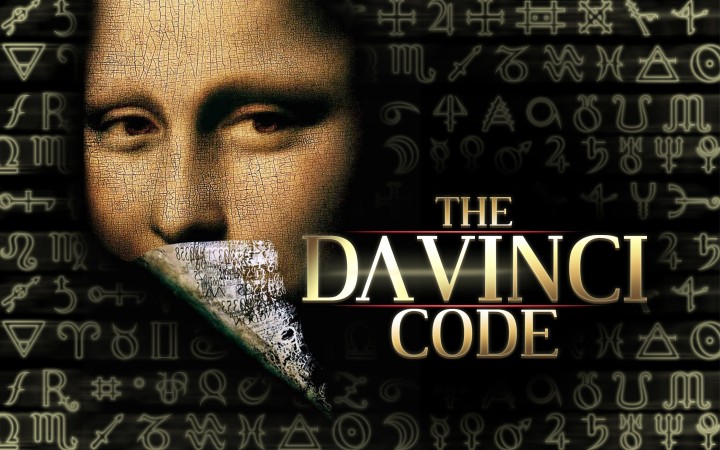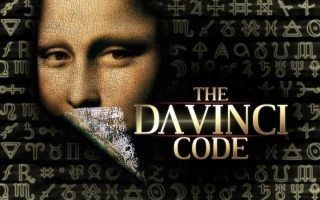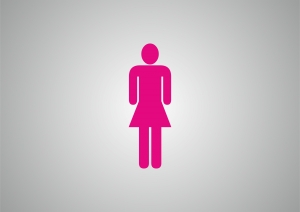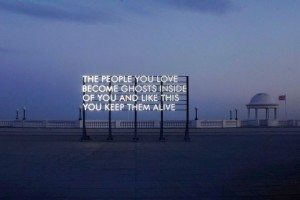By Catherine Schmidt, via ReligionNerd.com
 This is the final segment in a four part series that has discussed the myth of Mary Magdalene’s reputation in history and pop culture. In part I, pre-Vatican II depictions were discussed with The King of Kings as an example. Part II and part III built on post-Vatican II portrayals discussing Lady Gaga’s “Judas” and Jesus Christ Superstar, respectively. This final installment concludes with The Da Vinci Code.
This is the final segment in a four part series that has discussed the myth of Mary Magdalene’s reputation in history and pop culture. In part I, pre-Vatican II depictions were discussed with The King of Kings as an example. Part II and part III built on post-Vatican II portrayals discussing Lady Gaga’s “Judas” and Jesus Christ Superstar, respectively. This final installment concludes with The Da Vinci Code.
In 2003 a book came out that became a huge hit among readers. Since it was published, this book has sold more than 7.5 million copies in more than 40 languages world-wide.[1] Then, in 2006 it was released as a movie with superstars both directing (Ron Howard) and acting (Tom Hanks and Ian McKellen) in the film. The movie made over $77 million in its opening weekend in the United States and then went on to make over $217.5 million gross in the United States.[2] The year the film came out, it was beaten in the box office in gross sales by only one other film.[3] The book and film was The Da Vinci Code which claimed that the infamous Holy Grail was not a cup, but in fact a secret to the bloodline of Jesus and Mary. This Mary, unlike the Mary of Jesus Christ Superstar (see part III), knew how to love him. I will not go into details about the inaccuracies in the book and film, since many other scholars have already done so. What I will do, however, is discuss how by stating that Mary’s claim to fame was changed from first to witness and announce the resurrection to being the mother of Jesus’ child, Brown continues the long legacy of diminishing Mary’s role in history—and by extension, women.
In both the book and the film, Robert Langdon and Sophie Neveu are on the run from the law—and unbeknownst to them, the Catholic Church—when they arrive at the home of Sir Leigh Teabing. There is some discussion about a secret society, the Priory of Scion. According to Teabing, the Priory of Scion was charged with “protecting the greatest secret in modern history.” The discussion then moves to that secret, which involves the Holy Grail and Mary. The argument is that Mary, the secret wife of Jesus, was pregnant at the crucifixion and fled to France (leading to the numerous legends about Mary in France) for the birth of her daughter. The Catholic Church covered up the event because the men in charge did not want the concept of the Church being carried on by a woman to be made public. Teabing then goes on to argue that Leonardo da Vinci was aware of the secret and painted it into his Last Supper. The figure many people assume is John is actually Mary with no explanation of where John, the supposed Beloved Disciple in the gospel of John, was at the time of the last supper. The V shape between Jesus and Mary is the chalice and the ancient symbol for woman. Teabing then goes on to show “proof” in the non-canonical gospels of Philip and Mary that Jesus and Mary were married. At one point, Sophie does ask Teabing about Mary being a prostitute. To Brown’s credit, he does have Teabing offended by this statement. Teabing responds: “Magdalene was no such thing. That unfortunate misconception is the legacy of a smear campaign launched by the early Church. The early Church needed to defame Mary Magdalene in order to cover up her dangerous secret—her role as the Holy Grail.”[4] She was then “recast as a whore in order to erase evidence of her powerful family ties,” which Teabing claims is her relation to the tribe of Benjamin.[5] Brown’s “smear campaign” is the same as Ruether’s “mud-slinging job” (see Part I). The only difference is the reasoning. According to The Da Vinci Code, Mary was the Holy Vessel, the chalice, which allowed Jesus’ bloodline to continue for generations.
Though it was a fiction book, many readers (and later viewers when it was made into a film) believed what Brown wrote. Santana and Erickson made the argument that The Da Vinci Code is an example of a novel and film that is a “modern-day apocryphal gospel that people take as fact” and “has literally taken on the functional role of a religious text.”[6] People want to believe the claims made in The Da Vinci Code because it allows them to question the Catholic Church and, as Ehrman has argued, it just makes sense.[7] A married Jesus with children makes more sense to some people than a celibate man. Following this argument, some readers (and watchers) can relate better to a family-man Jesus than a single-bachelor Jesus. Another reason for the success is that novels and movies that are condemned by the Catholic Church sell well. People want to see for themselves what is causing such a stir.[8] The Catholic Church’s response to the book, The Da Vinci Code, made it clear what their opinion was of Brown’s ideas. On March 16, 2005, Cardinal Bertone, speaking on behalf of the Vatican, stated that the book was a “sack full of lies against the Church and against the real history of Christianity.” He went on to say that Brown was “shameful” for what he wrote.[9]
How, then, does The Da Vinci Code, demean the legacy of Mary? Is not the idea that she was the mother of Jesus’ child actually elevating her legacy? On the surface, it would seem so, but if one were to look deeper, he or she would understand that what it does actually “degrades the real Mary Magdalene.”[10] Her legacy changes from first witness and announcer of the resurrection—and therefore founder of Christianity according to Ehrman (see Part III)—to just a woman who carried Jesus’ child. It is her womb that is important, not what she sees and does. And just as reducing her to a prostitute reduced her to her sexuality, having her claim to fame being who she gave birth to because of Jesus reduces only what her sexual organs can do. Feminist scholars have argued that “by elevating Mary Magdalene to a position among women second only to that of the Virgin Mary, the Catholic Church reinforced the tendency to define women narrowly in terms of sexuality, a category which is at best ambiguous, at worst associated with corruption.”[11] Mary may be, according to Brown, the Holy Vessel, but she is still just a vessel, an instrument used for Jesus’ bloodline to continue. Following the argument that Mary was only important because she bore a child, then the only thing women are good for is bearing children and should not be leaders in the church.
actually elevating her legacy? On the surface, it would seem so, but if one were to look deeper, he or she would understand that what it does actually “degrades the real Mary Magdalene.”[10] Her legacy changes from first witness and announcer of the resurrection—and therefore founder of Christianity according to Ehrman (see Part III)—to just a woman who carried Jesus’ child. It is her womb that is important, not what she sees and does. And just as reducing her to a prostitute reduced her to her sexuality, having her claim to fame being who she gave birth to because of Jesus reduces only what her sexual organs can do. Feminist scholars have argued that “by elevating Mary Magdalene to a position among women second only to that of the Virgin Mary, the Catholic Church reinforced the tendency to define women narrowly in terms of sexuality, a category which is at best ambiguous, at worst associated with corruption.”[11] Mary may be, according to Brown, the Holy Vessel, but she is still just a vessel, an instrument used for Jesus’ bloodline to continue. Following the argument that Mary was only important because she bore a child, then the only thing women are good for is bearing children and should not be leaders in the church.
Unfortunately for Mary, each popular culture reference or portrayal of her is still the “conflated figure of legend” of either a whore[12], repentant or otherwise—as is the case with The King of Kings, “Judas”, and Jesus Christ Superstar—or the womb for Jesus to carry on his bloodline—as is the case with The Da Vinci Code. Modern scholarship has tried to correct the “mud-slinging job” started so very long ago against Mary, but in the eyes of the public, she is still either just a prostitute confused with many other women in the New Testament or the wife of Jesus. Mary has had many roles, both in history and popular culture. She symbolizes whatever society and culture need her to be at the time. She has been “honored, defamed, buried in silence, pushed to the margins, elevated to unreality, [and] degraded to an object of lust.”[13] Until popular culture—and not just academia—can portray Mary as the first to witness and announce the resurrection of Jesus and not as a “fame-hooker, prostitute, wench” or way for Jesus to have a child, the “mud-slinging job” done so long ago will continue. Mary, along with all women, will be demeaned in the eyes of popular culture. The only thing consistent about Mary currently in American popular culture is that she is portrayed inconsistently. However, the question arises of what, if any, role does popular culture play in teaching the public religious stories? Unfortunately for Mary, misrepresentations where first popularized by the Church itself and those representations have become the source for the popular culture portrayals. Does the author of the media have the right to do so for the sake of art? Or should the author be held responsible for the consequences of the image portrayed to audiences. Would characterizing Mary differently in popular media result in better opportunities for Christian women?
Mary Magdalene, I argue, needs to be rediscovered by popular culture. She needs to no longer carry the role of prostitute and be rediscovered as the apostle of the apostles: first to witness and announce the resurrection.[14] She must be rediscovered in order to be wiped clean of the ancient “mud-slinging job” and “smear campaign.” For over fourteen hundred years she has been portrayed in legend, art, sermons, novels, theater, film, music videos, musicals, and comic books as something that she was not. Mary needs to be seen as equal to the other apostles. Women need to be seen as equal to men. If popular culture depicts Mary not as a whore, but as what she really was—apostle of the apostles—society will be one step closer to equality and gender pluralism.
*********
Author’s Bio
Catherine Schmidt is an associate editor of Religion Nerd. Catherine earned her BA in Religious Studies at Arizona State University (2005) and her MA in Religious Studies at Georgia State University (2012). She has presented her work at academic conferences in the local, regional, and national level. Catherine’s interest range include: religion and popular culture, women and religion, Mary Magdalene, and early Christian history. She hopes in the future to pursue her PhD where she can combine her many interests.
[1]Hixon, J.B. “The Da Vinci CodePehnomenon: A Brief Overview and Response.” Journal of the Frace Evangelical Society.Autumn 2004. p 44. [2] “Da Vinci Code, The (2006).”IMDb. IMDb.com, Inc., Web. 26 June 2011. http://www.imdb.com/title/tt0382625/. [3]Plumer, Eric. The Catholic Church and American Culture: Why the Claims of Dan Brown Strike a Chord. Scranton: University of Scranton Press, 2009. p vii. [4] Brown, Dan. The Da Vinci Code. New York: Random House, 2003. p 320. [5]Brown p 327. [6]Santana, Richard W. and Gregory Erickson.Religion and Popular Culture: Rescripting the Sacred. North Carolina: McFarland & Company, 2008. p 9. [7]Ehrman, Bart D. Peter, Paul, and Mary Magdalene: The Followers of Jesus in History and Legend. Oxford: Oxford University Press, 2006. p 183. [8]Reidy, Maurice Timothy. “Why do so many people believe The Da Vinci Code is true? Fiction Trumps Fact.”America, Vol. 194 No. 20 (June 5-17, 2006). p 12. [9] Quoted in Plumer p 231. [10]Gerald O’Collins quoted in De Keijzer, Arne J. “Was She Married to Jesus?” Secrets of Mary Magdalene.Ed. Dan Burstein and Arne J. De Keijzer. New York: CDS Books, 2006. p 161. 11]Plumer p 249. [12]Schaberg, Jane. “Fast Forwarding to the Magdalene.”Semeia 74 (1996). p 35. [13]Maisch, Ingrid. Mary Magdalene: The Image of a Woman through the Centuries. Collegeville: The Liturgical Press, 1998. p ix. [14]Maisch p 180.






Pingback: Your Questions About Knights Templar | RicheousIndigNation